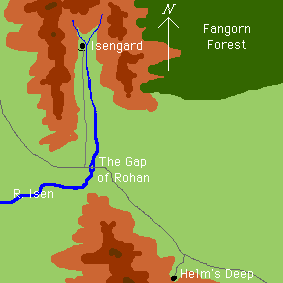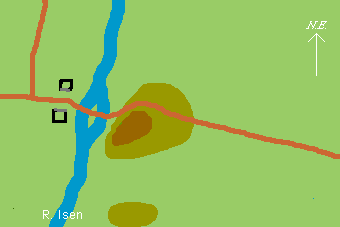Luke Ueda-Sarson's Fantasy Battle Scenarios for DBM:
The 1st battle of the Fords of Isen: 3019, Third Age


In 3019, during the War of the Ring, Saruman made his opening bid for power by attacking the Rohirrim garrisoning the Fords of Isen. His aim was to kill their comander, Theodred, the heir to the throne of Rohan, in order to deprive the country of leadership; the King haven been neutralised by his court agent Wormtongue.
In this Saruman's forces were eminently successful, but they missed a great opportunity in that they did not press their attack further once Theodred had been killed, for had they done so, the course of the war would have been changed much for the worse for those opposing Sauron. This failure to invade Rohan straight away would mean Saruman's forces would have to assault the fords once again at the Second battle of the Fords of Isen a week later.

The battle is well documented, being described some detail in Unfinished Tales (UT, p355 and following, page references from the 1983 reprint).
The battle site was the immediate vicinity of the Fords of Isen. The great road from Gondor to Eriador passed eastwards through the strategically important Gap of Rohan here, and crossed the river Isen aided by a small eyot or island which divided the river's flow.
The Isen should be depicted as a river between under 100p across - it was still relatively small at this point, being still not far from its source near Isengard, and not yet having joined with its major tributary, the Adorn. Its fordability should be graded as 'tricky', since the wording of the text implies that it could be crossed by small parties of men, if not whole armies, but it was also said to be very fast flowing, and deep even near its source. The section around the eyot should be classified as 'paltry', as the flow was here at its most broken, the river being broad and shallow, and it certainly presented no great obstacle to attackers. The portion that the road passes over should be counted as a proper ford. There were 3 rows of stepping stones for men on foot, whle horses used the main ford itself (TT, p192).
The eyot itself should just be large enough to hold a single foot element. The combination of the river and the low knoll in the middle of the eyot offered a degree of protection - any defending element on foot should gain a +1 combat factor against other foot; against mounted it must be doubled in combat to be destroyed, and cannot be recoiled (Elfhelm had to dismount his men to retake it). Only two elements at a time may attack an element defending the eyot in close combat, one from each side of the river.
Another road, running south from Isengard, allowed Saruman's forces to quickly approach the two earth-forts guarding the western approaches of the fords. These should be modelled as TF, each with a gate, but with internal dimensions of one base width for each face - not enough room for both an element of dismounted horse and their mounts (for when the Rohirrim cavalry dismounted, they had to leave their mounts outside).
A low gentle hill was positioned to the south, where the retreating Rohirrim sought to make a stand; there was also a ridge running east-west to the northeast of the battle field, but as this feature was some 3 miles from the Fords, it need not be worried about. The road running towards Helm's Deep and Gondor ran straight for a distance of two miles once it had left the immediate area of the Fords, there however was a bend in the road just before the Fords were reached, and it was not possible to see southwards towards the low hill there from the road just before the Fords, hence I position the road on the northern side of the slopes that went down to the Fords on their eastern side - these should be classified as steep just south of the road.
The river was seemingly bordered by terraces (TT, p192), but these are difficult to depict on the table-top; perhaps they are best left unrepresented and subsumed into the +1 tactical factor for defending a rver bank.

The Rohirrim were divided into 3 commands, one under the CinC, the other two under sub-generals. One command, of 4 companies under the white standard of the marshal of the Edoras Muster, Elfhelm, was initially absent from the field, as it was still riding westwards. It should therefore be counted as flank-marching, and if it dices successfully to arrive, it does so where the road enters the south-eastern edge of the board. Elfhelm's own company should be classified as Reg Kn (F), the other three companies as Irr Kn (F).
Theodred, the Rohirrim CinC, commanded 12 companies of horse, one of which was of mounted horse archers. His own company should be classified as Reg Kn (F), the horse archer company should be counted as two elemnts of Irr LH (F), so as to give Theodred the scouts that are mentioned in addition to the archers he kept with his main force, and the remaining 10 companies as Irr Kn (F). Theodred's command may deploy anywhere east of the west bank of the river (including the eyot) to a distance of 600p from the eyot (he had only just crossed the river when the battle began). His command should also include the Rohirrim 'baggage' - six elements of horse herds. These are of course mobile.
Grimbold, de facto commander of the Muster of Westmark, commanded his own company stiffened with 50 dismounted riders. This might best be classified as Reg Sp (I) to allow it to be supported by his followers, alternatively it should be classified as Reg Sp (O) to account for the dismounted riders in it when it is fighting without rear-rank support. In addition to these, he commanded the foot levies of Westfold. Their numbers are not mentioned, but must have been considerable, since they kept fighting on after Theodred's death and taking casualties themselves. They included only 'a handful' of archers - certainly not enough to make one element. As they formed a good enough shieldwall to keep out Dunlendings and Orcs. but not Uruk-hai, they are classified as Irr Sp (I). 18 elements will be sufficient to man the forts and the western fords, and ensure that Theodred's command is not over half the Rohirrim army. They must be deployed west of the river, within 600p of the eyot.
All Rohirrim mounted may dismount if their own general does so, Reg Kn as Sp (S), Irr Kn as Sp (O), LH as Bw (I). The Rohirrim total 286 AP including temporary fortifications if Grimbold is costed as Reg Sp (O). See the Rohan army list for more details on the Rohirrim. As the Rohirrim are defending, Saruman's forces will have the first move.
The strength of Saruman's forces that were committed to this battle, and indeed, even the names of their commanders, are entirely unknown. They did not include any pikeman, since Theodred had just fought these 20 miles to the north and ridden back to the Fords - they would not have had time to march south to participate in the battle. The forces of Saruman were split into two commands. The larger one was on the west side of the river; the smaller but more mobile was on the east. This consisted of a 'company' of axe-wielding men or half-orcs, two 'battalions' of Uruk-hai, plus numerous wolf-riders and some Dunlending horsemen.
Evidently a Sarumanic 'company' was larger than a Rohirrim one, since the single company of axe-men was large enough to assault Theodred's company on the eyot from both sides.
I suggest that this company be represented by two Bd (O) elements, one of which is the CinC. Since these axemen were destroyed immediately after killing Theodred, the otherwise inexplicable halting of the attack on the Rohirrim can be accounted for if their leader was also killed at this point.
Assuming a 'battalion' is four 'companies' (no reason why!), this gives us 8 elements of Uruks, classified as Reg Bd (F) - some carried bows, but shooting was very much a secondary consideration. See the Orthanc army list for details on the classifications of Saruman's troops.
The vanguard of Dunlending horsemen might be represented by 2 elements, and the 'great pack' of wolf riders by 8 elements, giving a command totalling 20 elements. It may deploy anywhere east of the river upto 600p in from the north-eastern table edge.
The larger western command was less mobile, but helped by marching along a road. The details of its compostion are not given, but would probably have consisted of those elements of Saruman's forces as not already represented in the eastern command, particularly those less mobile. I would give it the following: a Reg Bd (F) sub-general, 3 reg Bd (F) Uruk-hai, 4 Reg Bd (O) men and half-orcs, 10 Irr Ax (O) Dunlending hillmen, 4 Irr LH (O) wolf riders, 16 Irr Ax (O) armoured Orcs, 12 Irr Ps (O) Orc archers, 8 Irr Bw (I) Orc archers, totalling 52 elements, and a grand total of 362 AP for both commands. The western command may deploy anywhere west of the river upto 600p in from the north-eastern table edge.
The invaders gain a victory if they either break the Rohirrim in the 6 bounds before dusk, and they themselves have not had a command broken (they will then invade Westfold immediately), or if the destroy Theodred's element and they themselves are not broken and they haven't lost their own CinC's element. The Rohirrim will win if they break the invaders without becoming broken themselves, or, if both armies break, but Theodred's element survives. Any other result is a draw.

This page last modified: April 22, 2000